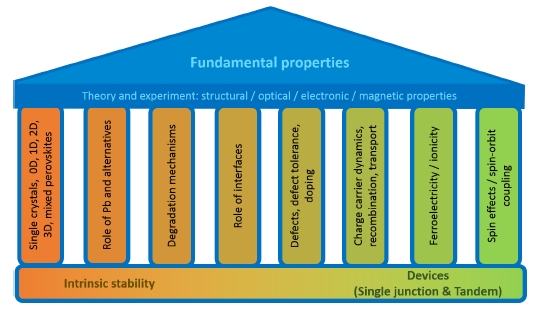

Summary of planned research activities
A new class of hybrid organic-inorganic lead halide perovskite semiconductors has attracted global attention since the reports on high efficiency perovskite solar cells in mid-2012. In only a few years photoconversion efficiency surpassing 22% has been achieved. Despite rapid progress in this emerging field, there is limited understanding of the basic mechanisms that lead to such an extraordinary performance. It is safe to say that it comes as a surprise that this material performs so exceptionally well in solar cells. Due to continuing optimization strategies, the originally simple perovskite crystal structure is getting more and more complex, leading to new challenges regarding phase and interface behaviour. Also, degradation mechanisms and the role of the toxic lead (and its replacement in high performing devices) are not clear.
Researchers worldwide have started to unravel the peculiar properties of these materials and devices, the role and interplay of their different components, and the control over the parameters dominating the solar cell performance. For exploiting the full potential of this new and exciting class of semiconductor, in solar-cell research and beyond, a concerted effort is needed to establish a fundamental and reliable knowledge base.
The research topic of this DFG Priority Programme (in German Schwerpunktprogramm, SPP) is highly interdisciplinary in nature, bridging chemistry, material science, device engineering, and physics. Therefore, we intend that every project participating in this SPP should have at least two PIs with different and complementary research expertise with the common aim to understand fundamental processes which play a role in perovskite semiconductors. Involvement of young and female investigators as PIs in the consortia will be explicitly encouraged.
The focus of the SPP will be on the investigation of fundamental working mechanisms. This includes structural, optical, electronic, and magnetic properties and, most importantly, their correlations. Some selected key areas that will be covered in the SPP, both experimentally and theoretically, are:
- Properties of nanostructured/0D/1D/2D/3D and mixed perovskites
- Role of lead and alternatives
- Degradation mechanisms
- Role of interfaces
- Defects and defect tolerance, doping
- Charge carrier dynamics, recombination and transport
- Role of ferroelectricity and iconicity
- Spin effects/spin-orbit coupling.
The proposed SPP is aimed to strengthen growing research efforts in Germany in different areas of fundamental studies on perovskite semiconductors and solar cells, to intensify collaborations between different groups and disciplines, theory and experiment, as well as to bundle top-expert knowledge available outside Germany, particularly in UK and Switzerland. Following strategic long-term key goals, such as perovskites for tandem solar cells, the replacement of toxic lead and a significant improvement in the intrinsic lifetime of perovskite solar cells will ultimately generate important technological advances and propel solar energy conversion in general. As recently pointed out by Michael Grätzel, one of the pioneer of dye-sensitized and perovskite photovoltaics: “We have not yet found a lead-free perovskite that would produce these high efficiencies, but one should not be dogmatic about this. New material discovery can happen any time, and research is actively continuing.”
